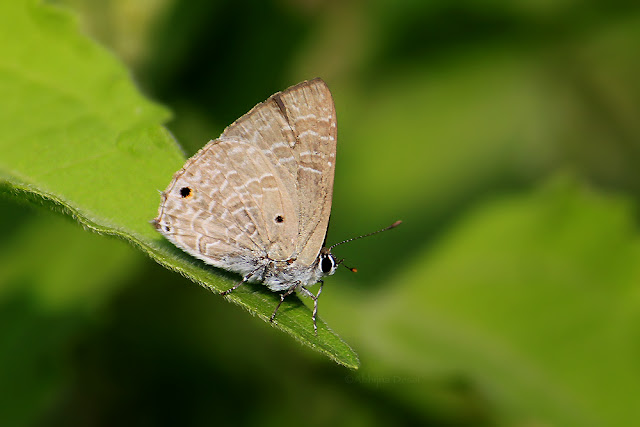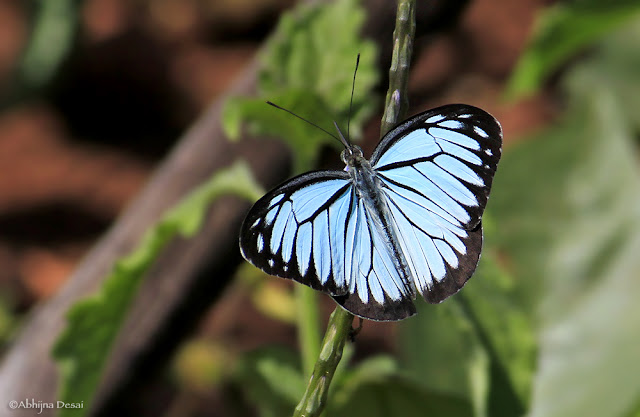I shall not put up a list, add some images and call this a trip report, because this was more than any ordinary trip I have had so far! Will elaborate on it, even though a few may appreciate brief and scientific writeups over lengthy and literature-like ones.
"Its raining here..." said Nitin's text the day before I started to Belvai. I was worried that this trip may not be productive due to the weather, and tried to calm myself down every time I was reminded of how badly I have been wanting to see the Malabar Banded Peacock (
Papilio buddha). This butterfly has been on top of my wish list for about three years now.
I reached Belvai at about 5 in the morning. It was too early for butterflies. But as there was a great gathering of butterfly enthusiasts (Milind Bhakare, Ashok Sengupta, Sammilan Shetty, Prashanth Bhat, Nitin Achari and myself) we kept talking and discussing about butterflies till the sun came up.
At Sammilan's farm by around 8am, I came across a bunch of Glassy Tigers (
Parantica aglea), Common Crows (
Euploea core) at first.
 |
| Two Glassy Tigers and a Common Crow |
Then, Medus Brown (
Orsotrioena medus), Grey Pansy (
Junonia atlites), Red Pierrot (
Talicada nyseus) and Tamil Grass Dart (
Taractrocera ceramas) joined the list.
Peacock Pansy,
Junonia almana:
Common Lascar (
Pantoporia hordonia):
Grey Count (
Tanaecia lepidea):
Afterwhich, we were stunned to see the Southern Birdwing (
Triodes minos) nectaring on the Ixora flowers. He was a sight to see! The graceful flight, the large yellow hindwings marked with black veins, and the sheer size of this beauty. It was captivating! A large number of butterflies love to nectar on this flower, because it contains many small flowers in one single bunch, and the butterflies find it easy to shift from one flower to another. This way, they have a big meal at once.
It was joined by both mimic forms of Common Mime (
Chilasa clytia), the form dissimilis which looks like the Blue Tiger and the form clytia which looks like the Common Crow. I was fortunate enough to get an image of the dissimilis:
10:30am was supposed to be the ideal time to sight a Malabar Banded Peacock at Sammilan's butterfly park, but our group had other plans. Even though I was a little disappointed to be leaving behind a sure chance of sighting one, I was filled with hopes of some great sightings at this waterfall in Someshwara WLS.
Our group was split into two, and we set off. We made countless stops in between. One one such stops, we found some Lycaenids fluttering on the road. Here, we found the Dark Pierrot (
Tarucus ananda).
A pretty little butterfly that this is, it was joined by some Line blues, of which one was a Pointed Line Blue (
Ionolyce helicon) which is a rarity. We clicked away, and after some time, it happened to sit on my index finger and enjoy a sip of sweat. We also saw Tamil Yeoman (
Cirrochroa thais) and Monkey Puzzle (
Rathinda amor).
As we walked on this path, we saw something that had everyone on their toes (Especially Milind sir), trying their level best to get a click at the very very rare Lycaenid. Ashok Sengupta sir confirmed it's identity as a Tamil Oakblue (
Arhopala bazaloides). Luckily, I managed the one of the best shots clicked by the group:
We also saw a number of Common Nawabs (
Polyura athamas) and an Anomalous Nawab (
Polyura agraria). The Nawabs seemed to love human sweat more than any other butterfly. One of them was an injured individual, and it settled on my nose for about 20 minutes.
Here, we also saw another very beautiful and big butterfly endemic to the Western Ghats, the Tamil Lacewing (
Cethosia nietneri).
Followed by this, we saw a Commander (
Moduza procris), a Chestnut Streaked Sailer (
Neptis jumbah) and a Clipper (
Parthenos sylvia) of which Milind sir got an absolutely perfect shot!
Throughout the way, we saw plenty of Southern Rustic (
Cupha erymanthis):
A few kilometres ahead, I spotted a bright orange butterfly move across the road and we halted the car. When we got down to see what it was, we found that it was the rare
Curetis siva, Shiva's Sunbeam. Nothing beats the mega-lifer of a rare butterfly when you've spotted it yourself. If this excitement is coupled with the best shot you can ask for, the happiness flies overboard and creates euphoria!
When we reached the waterfall, we were greeted by the lovely sight of mudpuddling Common Jays (
Graphium doson) and Bluebottles (
Graphium sarpedon). Next to which there was another group of mudpuddling Common Albatrosses (
Appias albina) and Mottled Emigrant (
Catopsilia pyranthe) This is a common sight in the Western Ghats after a rainy day. A little while later, these were joined by the Lesser Gull (
Cepora nadina), the Painted Sawtooth (
Prioneris sita), which are not as common as the rest of them in the group.
 |
| Mottled Emigrant and Common Albatross mudpuddling |
 |
| Common Jay upper side. |
 |
| Lesser Gull (left), Painted Sawtooth (middle) and Common Albatross. |
 |
| Common Jay, Bluebottle, Common Albatross and Painted Sawtooth mudpuddling! |
We also came across a very strange looking Lycaenid which hasn't been identified yet. Looks like it has lost scales, or it might be a colour aberration.
We also saw a few small sized Pointed Ciliate Blues (
Anthene lycaenina) and a Club Beak (
Libythea myrrha).
Just when we thought we had seen all the beautiful butterflies here, a Tawny Rajah (
Charaxes bernardus) made a grand guest appearance. He was gone before we knew it. Those who didn't get a picture frantically looked for it for a while, and we saw it once again on the trees even though none could succeed at clicking.
This place was an absolute butterfly treat for our group. Everyone was happy. We started off towards Belvai again and reached by about 6pm. We halted in between when we saw this Blue Mormon (
Papilio polymnestor) resting after its day:
I didn't find the Malabar Banded Peacock after all this action, but I was overwhelmed by all that I had seen in one single day. It was way too many lifers to handle.
I had to hurry to Dharmastala because my plans differed slightly, so our group clicked a picture before I left. All of us had become "worn out specimens" by the end of the day, covered in dirt and mud, but we were still in the rejoicing mood of finding a rare new species - the Pointed Lineblue. None of us seemed to be tired, and this is definitely thanks to the passion we all share about the Winged Jewels!
 |
| From left - Sammilan Shetty, Ashok Sengupta, Abhijna Desai, Nitin R Achari, Milind Bhakare and Prashanth Bhat! |
The picture is clicked by Ganesh Desai, my brother, who also had a lot of fun on the trip.
This was a very memorable trip, and I shall look forward to meeting these amazing people once again very soon. Heartfelt thanks to Sammilan for all the effort he has undertaken to provide this opportunity for us. His butterfly park is complete with host plants and nectar plants that attract a large number of butterflies from all the sub-families. He has also strategically placed rotten fruits and such other butterfly-bait in the right places, so as to get the butterflies' attention. Also, a special thank you to Sammilan's mom, Manimala aunty, for her care and hospitality. She cooked some really delicious Mangalorean food for us! It was an absolute pleasure to be there, and an even bigger pleasure to be with the people who I was with.
Cheers!






































































